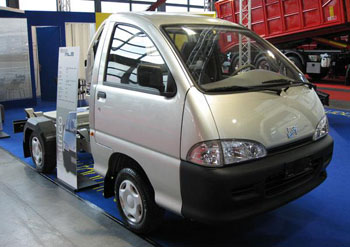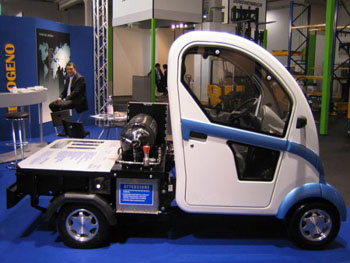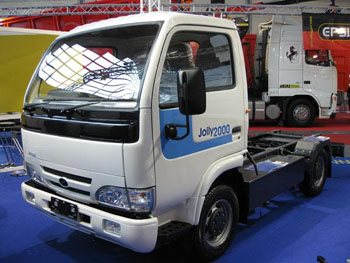

 |
|
FAAM Group
currently manufactures a range of
battery-powered zero-emission service
vehicles including the Ecomile Elettrico
(top), Smile H2 (middle) and Jolly 2000
(bottom). |
|
|
|
Magneti Marelli and FAAM, a manufacturer of starter batteries
and industrial traction batteries, have signed an agreement
for the development, production and marketing of innovative
lithium traction batteries and the related control and
management systems (BMS, Battery Management System).
The
agreement provides for joint development of the products and
their marketing by the second half of 2010. FAAM will make
available its know-how and technological leadership in
energy accumulation systems for industrial and automotive
use. Magneti Marelli will share its know-how on the
integration of complex systems, and specifically on control
and power electronics and energy accumulation and recovery
systems, such as the KERS (developed by Magneti Marelli for
Formula 1 use), where hi-tech components such as the
motogenerator, the inverter, batteries and battery
monitoring and control system, are integrated in an
environment with high levels of stress.
The
agreement aims at establishing a competitive offer with high
technological contents in a sector that is of primary
strategic importance in the scenario of sustainable mobility
of the future and in the area of hybrid and electric
engines. Magneti Marelli and FAAMíS new lithium traction
batteries and relevant BMS (Battery Management System) are
specifically intended for the area of transportation and
"mobility" in a wide sense, aimed at the world of
automobiles, motorcycles, buses and industrial vehicles,
motor homes and boats as well as at the segment of
manufacturers of industrial and agricultural equipment, such
as forklift trucks, tractors, machines and means for
logistics and industrial cleaning.
The
partnership is also open to the establishment of other
collaborations with leading international entities in the
sector, and looks with interest at the development of
activities and projects falling within the scope of
government initiatives and approaches in the field of energy
policy and research.
"In a mobility
system that is destined to radically change due to the push
of new global scenarios," stated Eugenio Razelli, Magneti
Marelliís CEO. "This agreement aims to provide innovative
solutions in response to the new technological challenges
concerning transportation means and "sustainable" engines,
such as hybrid and electric engines. Hence a new partnership
is created between two leading entities in the Italian
automotive production chain, open to the integration of the
best technologies at the global level, capable of offering
high-level skills and technologies in the sector of traction
batteries."
"FAAM Group has
been committed for more than 20 years in the Research and
Development of innovative solutions on the subject of
mobility," added Federico Vitali, President of FAAM Group.
"To us, the agreement with MM means making our know-how
available and becoming part of a global network for the
development of electric drive systems for road vehicles.
Today there is finally the awareness that electric vehicles
are a reality: due to their characteristics and
performances, lithium batteries represent their genome. By
signing this agreement, MM and FAAM want to be the reference
partner for manufacturers of automobiles and industrial
vehicles throughout the world."
FAAM, produces and
sells lead and lithium batteries, fuel cells and electrical
vehicles. Its production plants are located in Italy, in the
Marche and Puglia regions, in Uruguay for the Mercosur area
and in China for the Chinese and Asian market. Its business
areas include starter, stand-by and motive power batteries,
electrical vehicles, fuel cell systems and lithium batteries
with relevant BMS. The Group, which has always been involved
in R&D for the purpose of "delighting the customer", also
has a capillary service network distributed throughout the
Italian territory to answer customer needs in real time and
satisfy requests in terms of functionality, image and
performance.
|
|
|